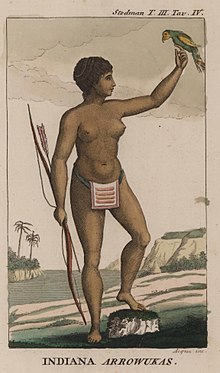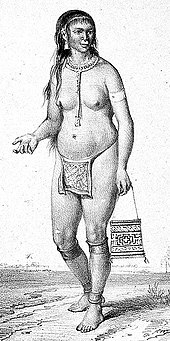Arawak

The Arawak , Aruak or Arawaken (from the Lokono aru " cassava flower") were an indigenous people on the north coast of South America . The Arawak are eponymous for the Arawak language- speaking tribes that can be found or found in parts of South America.
designation
The name was first used by the Spanish colonists as a name for the Taíno in the Greater Antilles and Bahamas ( Lucayan ), the Nepoya and Suppoyo in Trinidad and the Igneri in the Lesser Antilles as well as linguistic groups (including the Lokono ) along the northeast coast of South America (also Brazil ) is used. All of these peoples spoke an Arawak language.
language
Their language is Arawak ( ISO 639 : ARW), which is still spoken by 700 people in Suriname and 1500 in Guyana .
cult
Of particular importance for the Arawaks was a triangular, notched, zemi ("holy") stone - probably symbolizing a mountain or volcano - which denoted the hierarchical position of the patron god for every household, but also for gods, idols, the deceased and the cosmic powers stood. Similar symbols existed in Haiti , Puerto Rico, and the Dominican Republic . Zemí corresponds roughly to the Wak'a (huaca) in the Andes. The symbol was used in a ritual in which ritual specialists sniffed tobacco with a hallucinogen and, in a trance, prophesied the future by making contact with the zemí .
Settlement area
Nowadays, Arawak ethnicities only exist in mainland America. On the Atlantic coast of Honduras , Guatemala and Belize , around 130,000 Garifuna speak a further developed form of the Igneri language from the mixture of island caribs, the Igneri Arawak who were once subjected to them and Afro-American slaves who had fled. About 140,000 Wayuu , who belong to the Arawak , live on the Guajira Peninsula , which belongs to Colombia and Venezuela .
history
Way of life before 1500
The Arawaks lived in village communities and cultivated cereals , sweet potatoes and manioc , among other things . You could e.g. B. spinning and weaving, but kept no livestock and had no iron.
Colonization and extermination
The Arawak were exterminated by enslavement , persecution, the robbery of agricultural land and the transfer of ownership to Spanish landowners and introduced diseases after a hundred years of Spanish Conquista .
While the Caribs were characterized as warlike by the Spanish, the Arawak were generally considered to be peace-loving. Columbus described them as naive and noted in the logbook “They offer everyone to share [their goods]”. First encounters with the navigator in Spanish service Christopher Columbus in 1492 were peaceful, the Arawaks offered the seafarers, according to Columbus' logbook, among other things cotton, and the seafarers exchanged, among other things, glass beads. Columbus always viewed them as future subjects or even as slaves.
Shortly afterwards, the Spaniards arrested Arawaken and questioned them about gold deposits. Spanish settlers enslaved the Arawaks, abused them and forced them to work. They could not find gold, so Columbus brought slaves to Spain instead of gold (which he had promised the Spanish rulers). The Arawak tried to defend themselves, but their weapons were clearly inferior to those of the Spaniards. Because of the hopeless situation, there was mass suicide among the Arawaks.
In 1515 their number in Haiti had decreased from around 250,000 to an estimated 50,000, in 1550 there were still around 500 people. A report from 1650 found no remaining Arawaks.
See also
- Orinoco Parima cultures (Indian societies in South America)
- indigenous peoples of Central America and the Caribbean
Web links
- Lexicon entry: Arawak. In: The Columbia Encyclopedia. 6th edition. Columbia University Press, undated.
- Stephen D. Glazier: Caribbean Religions: Pre-Columbian Religions. In: Encyclopedia of Religion. Thomson Gale, USA 2005, original: 1987 (with detailed information about the Arawak).
- Noble David Cook: Taino (Arawak) Indians. In: Encyclopedia of Genocide and Crimes Against Humanity. Gale Group, USA 2005.
Individual evidence
- ↑ Michael D. Coe (ed.), Dean Snow, Elizabeth Benson: World Atlas of Ancient Cultures: America Before Columbus. History, art forms of life. Christian, Munich 1986, ISBN 3-88472-107-0 , pp. 161/162.
- ^ A b Howard Zinn : A People's History of the United States : 1942-present. Harper Perennial Modern Classics, New York 2005, ISBN 0-06-083865-5 , p. 3.
- ^ Howard Zinn : A People's History of the United States : 1942-present. Harper Perennial Modern Classics, New York 2005, ISBN 0-06-083865-5 , pp. 4/5.
- ^ Howard Zinn : A People's History of the United States : 1942-present. Harper Perennial Modern Classics, New York 2005, ISBN 0-06-083865-5 , p. 5.
This article is based on the article Arawak ( memento of July 1, 2010 in the Internet Archive ) from the free encyclopedia Indianer Wiki ( memento of March 18, 2010 in the Internet Archive ) and is under Creative Commons by-sa 3.0 . A list of the authors was available in the Indian Wiki ( Memento from July 1, 2007 in the Internet Archive ).
